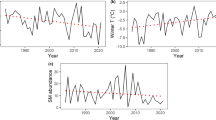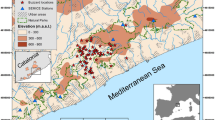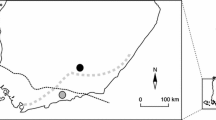Abstract
We used a 13-year time series of abundance estimates of breeding Northern Saw-whet Owls (Aegolius acadicus), and of small mammals from central Ontario, Canada, to assess the numerical response of the owls to small-mammal prey species. We found that the finite rate of increase of breeding owls was directly related to estimates of red-backed vole (Myodes gapperi) abundance. Thus, it appeared that the owls were nomadic, and made decisions about where to breed based on vole supply. The owls showed a much weaker response to deer mouse (Peromyscus maniculatus) abundance. Across all years, 55% of variation in owl rate of increase could be uniquely attributed to vole abundance, whereas only 3% could be attributed to mouse abundance. Consistent with the model of nomadism, there was only a weak relationship between the proportion of hatch-year owls caught at fall banding stations, and small-mammal abundance. Instead, it appeared that Northern Saw-whet Owls avoided years of widespread reproductive failure through the nomadic strategy of selecting breeding sites based on vole supply.





Similar content being viewed by others
References
Andersson M (1980) Nomadism and site tenacity as alternative reproductive tactics in birds. J Anim Ecol 49:175–184
Andersson M, Erlinge S (1977) Influence of predation on rodent populations. Oikos 29:591–597
Badzinski DS (2007) Ontario nocturnal owl survey: 2007 final report. Bird Studies Canada
Baker RH (1968) Habitats and distribution. In: King JA (ed) Biology of Peromyscus (Rodentia). Spec Publ No. 2, Am Soc Mammal, pp 98–126
Baumgartner FM (1939) Territory and population in the great horned owl. Auk 56:274–282
Bowman J, Forbes GJ, Dilworth TG (2001a) The spatial component of variation in small-mammal abundance measured at three scales. Can J Zool 79:137–144
Bowman J, Forbes GJ, Dilworth TG (2001b) Landscape context and small-mammal abundance in a managed forest. For Ecol Manag 140:249–255
Bowman J, Donovan D, Rosatte RC (2006) Numerical response of fishers to synchronous prey dynamics. J Mammal 87:480–484. doi:https://doi.org/10.1644/05-MAMM-A-202R2.1
Bowman J, Phoenix RD, Sugar A, Dawson FN, Holborn G (2008) Spatial and temporal dynamics of small mammals at a regional scale in Canadian boreal forest. J Mammal 89:381–387. doi:https://doi.org/10.1644/07-MAMM-A-147R1.1
Bulmer MG (1975) Phase relations in the 10-year cycle. J Anim Ecol 44:609–621
Cannings RJ (1993) Northern saw-whet owl (Aegolius acadicus). In: Poole A, Gill F (eds) The birds of North America, No. 42. The Birds of North America, Philadelphia
Côté M, Ibarzabal J, St-Laurent M-H, Ferron J, Gagnon R (2007) Age-dependent response of migrant and resident Aegolius owl species to small rodent population fluctuations in the eastern Canadian boreal forest. J Raptor Res 41:16–25. doi:https://doi.org/10.3356/0892-1016(2007)41[16:AROMAR]2.0.CO;2
Elias SP, Witham JW, Hunter ML Jr (2006) A cyclic red-backed vole (Clethrionomys gapperi) population and seedfall over 22 years in Maine. J Mammal 87:440–445. doi:https://doi.org/10.1644/05-MAMM-A-170R1.1
Fryxell JM, Falls JB, Falls EA, Brooks RJ (1998) Long-term dynamics of small-mammal populations in Ontario. Ecology 79:213–225
Koivula M, Viitala J (1999) Rough-legged buzzards use vole scent marks to assess hunting areas. J Avian Biol 30:329–332
Koivula M, Korpimäki E, Viitala J (1997) Do Tengmalm’s owls see vole scent marks visible in ultraviolet light? Anim Behav 54:873–877
Korpimäki E (1994) Rapid or delayed tracking of multi-annual vole cycles by avian predators? J Anim Ecol 63:619–628
Korpimäki E, Norrdahl K (1991) Numerical and functional responses of kestrels, short-eared owls, and long-eared owls to vole densities. Ecology 72:814–826
Marks JS, Doremus JH (2000) Are northern saw-whet owls nomadic? J Raptor Res 34:299–304
O’Donoghue M, Boutin S, Krebs CJ, Hofer EJ (1997) Numerical responses of coyotes and lynx to the snowshoe hare cycle. Oikos 80:150–162
Poulin RG, Wellicome TI, Todd LD (2001) Synchronous and delayed numerical responses of a predatory bird community to a vole outbreak on the Canadian Prairies. J Raptor Res 35:288–295
Rasmussen JL, Sealy SG, Cannings RJ (2008) Northern saw-whet owl (Aegolius acadicus). In: Poole, A (ed) The birds of North America online, No. 42. Cornell Laboratory of Ornithology
Rohner C (1996) The numerical response of great horned owls to the snowshoe hare cycle: consequences of non-territorial “floaters” on demography. J Anim Ecol 65:359–370
Rowe JS (1972) Forest regions of Canada. Canadian Forest Service, Department of the Environment, Ottawa
Solomon ME (1949) The natural control of animal populations. J Anim Ecol 18:1–35
Viitala J, Korpimäki E, Palokangas P, Koivula M (1995) Attraction of kestrels to vole scent marks visible in ultraviolet light. Nature 373:425–427
Weir RD, Cooke F, Edwards MH, Stewart RB (1980) Fall migration of saw-whet owls at Prince Edward Point, Ontario. Wilson Bull 92:475–488
Acknowledgments
Funding for this work was provided by the Ontario Ministry of Natural Resources, Bird Studies Canada, Long Point Bird Observatory, the University of Guelph, and the Natural Sciences and Engineering Research Council of Canada. We thank the many technicians and the volunteer owl surveyors and banders who to helped collect the data. Jeff Marks and Matt Reudink provided helpful comments on the work.
Author information
Authors and Affiliations
Corresponding author
Additional information
Communicated by F. Bairlein.
Rights and permissions
About this article
Cite this article
Bowman, J., Badzinski, D.S. & Brooks, R.J. The numerical response of breeding Northern Saw-whet Owls Aegolius acadicus suggests nomadism. J Ornithol 151, 499–506 (2010). https://doi.org/10.1007/s10336-009-0482-3
Received:
Revised:
Accepted:
Published:
Issue Date:
DOI: https://doi.org/10.1007/s10336-009-0482-3




